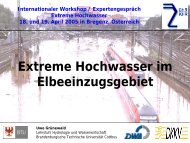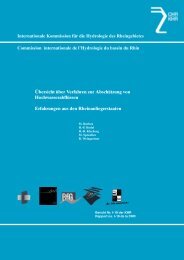ABSTRACTS 'Extreme Discharges' - CHR-KHR
ABSTRACTS 'Extreme Discharges' - CHR-KHR
ABSTRACTS 'Extreme Discharges' - CHR-KHR
Create successful ePaper yourself
Turn your PDF publications into a flip-book with our unique Google optimized e-Paper software.
Regional Flood Process Types<br />
Ralf Merz<br />
Günter Blöschl<br />
Institut für Wasserbau und Ingenieurhydrologie<br />
Technische Universität Wien<br />
Karlsplatz 13, A-1040 Vienna, Austria<br />
merz@hydro.tuwien.ac.at<br />
bloeschl@hydro.tuwien.ac.at<br />
Understanding the physical processes giving rise to floods of a given probability of occurrence is among the<br />
most intriguing areas of catchment hydrology. Not only are these processes complex and controlled by a range<br />
of variables including rainfall regime, snowmelt, state of the catchment and catchment characteristics but also<br />
their interaction is intricate and has so far defied detailed analyses at the regional scale. In this paper we propose<br />
an approach for identifying types of causative mechanisms of floods on the entire flood peak sample of all<br />
catchments in a region. The types are long-rain floods, short-rain floods, flash-floods, rain-on-snow floods and<br />
snow-melt floods. We adopt a catchment perspective, i.e. the focus is on the catchment state and the atmospheric<br />
inputs rather than on atmospheric circulation patterns. We use a combination of a number of process indicators<br />
including the timing of the floods, storm duration, rainfall depths, snow melt, catchment state, runoff<br />
response dynamics and spatial coherence. Table 1 gives a summary of the envisaged characteristics of the indicators<br />
for each of the process types.<br />
Flood indicators such as the seasonality of floods the spatial extent of catchments that are covered by the same<br />
flood were extracted from the maximum annual flood peaks data of 490 Austrian catchments, with observation<br />
periods from 5 to 44 years. Daily precipitation data from 1029 stations as well as air temperature data were regionalized<br />
to estimate catchment rainfall and to simulate the snow water equivalent and soil moisture state of<br />
each catchment using a conceptual water balance model. In addition, a data set consisting of the depths and durations<br />
of extreme rainstorms in Austria was used as an indicator to storm type. Catchment response times of<br />
flood events were inferred from the ratio of the maximum annual flood peak and the average daily runoff on the<br />
day the flood peak occurred. All observed flood peaks were classified manually on a flood event basis with the<br />
help of diagnostic maps (Merz and Blöschl, 2003). For each flood event, maps contained the information of all<br />
indicators in a way that grasping the essence of the flood processes was a matter of a few minutes for the analyst.<br />
Each map covered all of Austria and consisted of different layers, representing the different flood indicators<br />
discussed above.<br />
25





